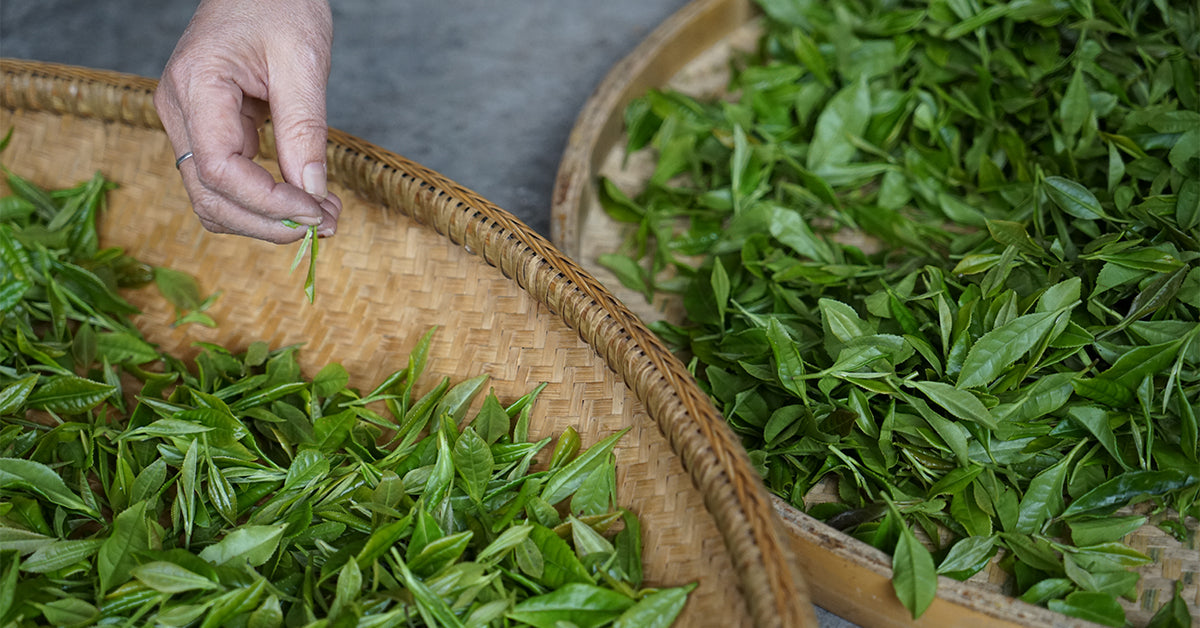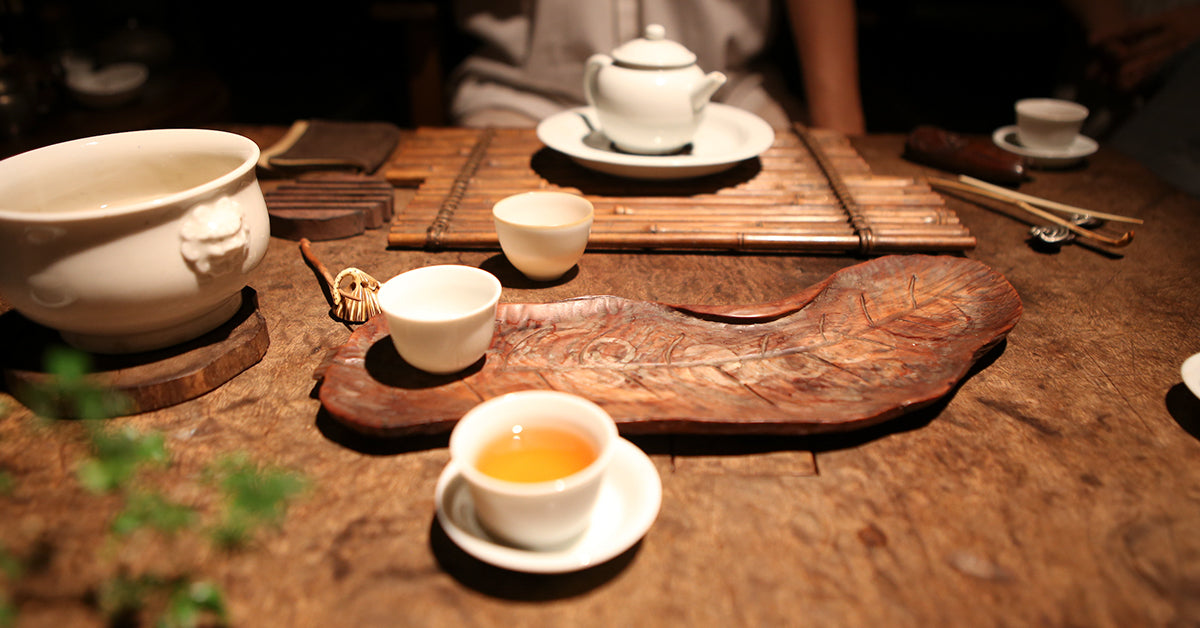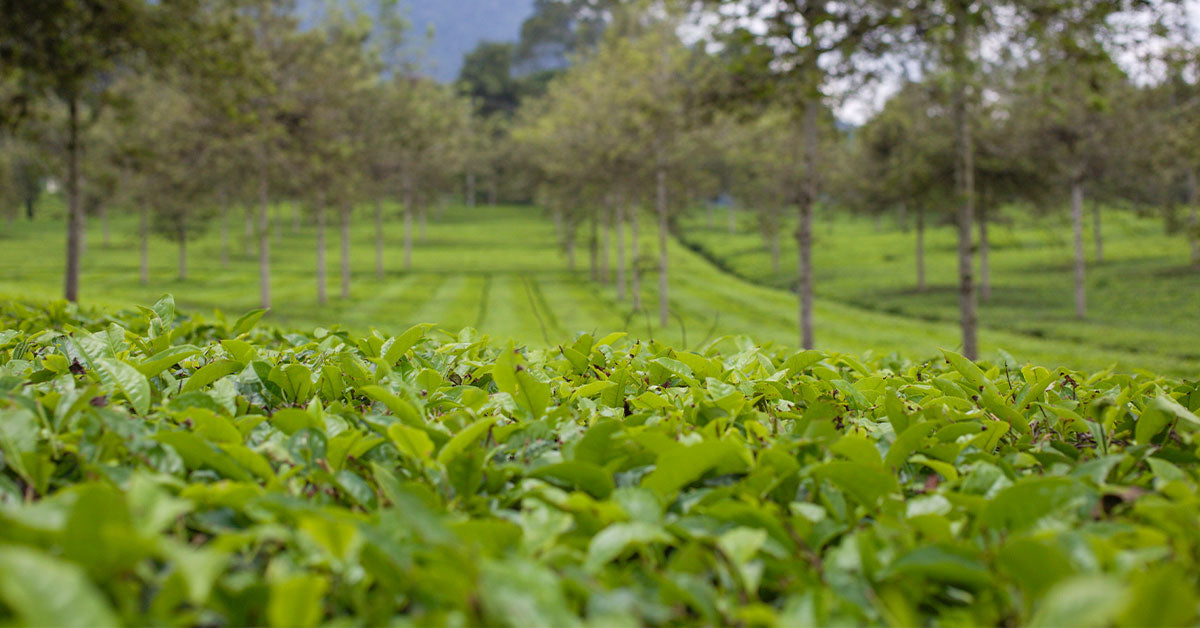Welcome to Tree to Tea, Part 2! We began this blog series last month with - you guessed it -- Part 1, which focused on the first stages of how tea gets from the earth to your cup: growing, harvesting, and withering. Much of that information, same as the info that follows, is harvested from my dad’s book, The Harney & Sons Guide to Tea. It’s a wonderful introduction to the world of tea exploration for those interested in going from tea novice to tea aficionado. It also makes my dad smile every time one of his books is purchased by a customer.
Our journey from tree to tea continues with the final six stages of a tea plant’s journey. We pick up from where we left off with withering to the next stage, fixing. Warning: science ahead.

Fixing
Makers of green teas bring all the aromatic activity that takes place in the withering stage to a halt when they “fix” the leaves, cooking them to keep them green. In the fruit and vegetable world, this reaction is called “enzymatic browning” and affects a host of foods including bananas, avocados, potatoes, and apples. If you slice open a potato, within a few minutes the exposed flesh will begin to darken. If you cook the potato, it will remain white. Tea makers similarly rapidly increase the leaves’ internal temperature to 160° F, deactivating the enzyme polyphenol oxidase, or PPO, that would otherwise turn them brown. (Another way to deactivate PPO is to deprive the enzyme of water, which it also needs to perform its duties. Uva Highlands Ceylon tea and First Flush Darjeelings desiccate so severely after harvest that they undergo what’s called a “hard wither,” drying out in heated troughs to such an extent that they become partially fixed, like green teas.)
The fixing method impacts the tea’s final taste. Imagine the difference between a steamed potato wedge and a browned, roasted one, and you have a sense of the difference. Japanese green-tea makers steam their leaves in tunnels, giving the teas the more assertive, vegetal flavors of steamed spinach. Since World War II, some Japanese tea makers have begun steaming the leaves twice as long, for up to a minute instead of the traditional 30 seconds. The increase may seem slight, but it results in an even more assertive tea.
Certain Chinese green teas like Bi Lo Chun and Lung Ching have the lighter, slightly sweeter flavors of toasted nuts and steamed bok choy in part because Chinese tea makers sear the leaves over woks. The much hotter pans and ovens trigger what chemists call “the Maillard reaction.” Named for Louis-Camille Maillard, the French chemist who first studied it at the turn of the last century, the reaction creates pyrroles, pyrazines, and other compounds tasting of baked peaches, roasted nuts, and similar baked or roasted flavors. A form of nonenzymatic browning, the Maillard reaction also darkens the teas somewhat.
Woks and ovens also give Chinese green teas a slightly wider range of aromas. Leaves reach 160° F almost instantaneously when they are steamed, but they can take several minutes to heat up in a wok or a hot oven. Until they are fixed, the leaves continue to wither, producing yet more aromatic compounds. A comparison of the aromas in a Japanese Sencha and a Chinese wok-fired green tea shows that the Sencha has more lemony linalools, while the wok-fired tea has more carroty beta ionones and neriols, floral aromas more common to oolongs, which wither for a much longer period. Although Chinese green teas have nowhere near the aroma concentration of oolongs, they do have a slightly wider spectrum of scents than Japanese green teas.
[I’ll pause now before the next stage so you can break out your Merriam-Webster and look a few words up.]

Rolling
After green teas have been fixed, and before black teas darken, tea makers roll the leaves to give them their lovely shapes. Once done by hand but now performed mainly by machine, rolling transforms the flat leaves into mesmerizing twists, coils, balls, or spears. In general, lightly rolled teas have mellower and gentler flavors, while leaves rolled with greater pressure break up into smaller pieces and form brews that are more brisk and intense. Chinese tea makers have invented innumerable ballet-like hand movements over the centuries to create dozens of leaf shapes. In the 1880s, the British developed rolling machines that saved labor but made far less distinctive shapes and less refined teas.
Oxidation
Where rolling gives green tea leaves their lovely shapes, with oolongs and black teas it also provokes the reaction that darkens the leaves. Oolongs and black teas are not fixed green but are allowed to darken through a process called “oxidation.” In the tea world, for centuries this process was mistakenly called “fermentation,” on the assumption that yeasts or bacteria were involved. In fact, the reaction involves only polyphenols and oxygen.
In a healthy tea leaf, polyphenols reside in “vacuoles,” small chambers inside the plant cells, ready to defend the leaf against damage from insects and other hazards. If insects munch on the cells or strong winds bruise the leaves as they rub against one another, or a tea maker macerates a leaf during the rolling process, the vacuoles also break, releasing the polyphenols into the cell’s cytoplasm. In the cytoplasm, the polyphenols encounter the enzyme polyphenol oxidase or PPO. In green teas, this enzyme does nothing, as it gets deactivated when the leaves are fixed -- heated to 160° F to render the enzyme inoperable. In oolongs and black teas, however, PPO reacts with the polyphenols and oxygen to form brown-colored compounds. In nature, these polyphenols are thought to deter further attack by giving the insects a stomachache. Luckily for tea drinkers, polyphenols are delicious as well as lovely to behold. In tea, there are two principal types of polyphenols, each with its own flavor and color. Golden, brisk theaflavins are the first to emerge. Later, thearubigins develop, mellower and with a lovely copper hue. The slower the oxidation, the more thearubigins, the gentler the teas. [Learn more about theaflavins and thearubigins in this blog post.]

Oolongs oxidize more slowly than other teas. As a result, they have the most complex, mellow flavors. Some Oolongs start to oxidize when they wither because tea makers gently fluff the leaves on tarps in the sun. This fluffing qualifies as a very light rolling, triggering oxidation along the edges of the leaves. Indeed, the gentle agitation is what gives oolong leaves their characteristic red tinge. With a head start on oxidation, the edges turn a darker red than the rest of the leaf. After withering, the leaves are rolled incrementally, in an elaborate stop-and-start oxidation that lasts for six hours or more. This gradual oxidation prolongs the withering, allowing for the creation of yet more aromatic compounds. The final flavors and aromas depend entirely on the amount of time the oolongs are given to wither and oxidize. Oolongs that oxidize roughly 25% contain high concentrations of linalool, methyl jasmonate, and indole and thus have the citrus and floral aromas of lime, jasmine, and gardenia. Those that oxidize between 40% and 75% develop more of the apricot and peach flavors typical of carotenoid degradation, the later-stage transformation of the pigment carotene into the apricot-like compounds ionones, damascones, and damascenones.
Chinese black teas share many of these apricot notes. Though they oxidize more quickly than oolongs because of stronger rolling, they still oxidize slowly enough to produce sweet, mellow thearubigin-rich teas. The oxidation is slowed not by interruption, but by limiting the leaves’ access to oxygen. Traditionally, tea makers would begin by rolling the leaves very gently, keeping them as whole as possible so that most of the polyphenols stay in their vacuoles. Then they pile the rolled leaves into deep, finely woven bamboo baskets. They leave them there for hours, covered with cloth, so oxygen reaches the leaves only at a trickle. The result is a soft, nuanced tea with full, rounded body.
British Legacy Teas -- what we call teas developed by the British in South Asia -- share a briskness that comes from being oxidized very quickly. Likely because the British have long preferred a brisk tea, tea makers in the former British colonies roll their leaves into much finer particles. They then spread the particles in thin layers, often blown with heated air, which maximizes their exposure to oxygen. Orthodox British Legacy Teas are allowed to oxidize longer and more slowly, so they have more complex aromas.
In contrast, British Legacy CTC teas are the most astringent of all, as they oxidize virtually instantaneously. CTC stands for “crush, tear, and curl,” the three stages of the “rolling,” or crushing, process: the leaves are not rolled but pulverized, crushed through a fine sieve to tear into tiny shreds that curl into fine pellets. These pellets pass along a conveyor belt under powerful blowers; within the space of one hundred feet and a few hours, the pellets have switched, chameleon-like, from bright green to a flat, dull brown. These teas have almost no thearubigins; their tannic theaflavins make them robustly brisk and mouth-puckering. These teas taste so good with milk because the dairy proteins bind with the tannic compounds to soften them.
While oxidation turns buds gold, it darkens mature tea leaves almost to black. The source of the darker color is chlorophyll, which degrades during oxidation to murky brown pheophytins and pheophorbides. Buds contain very little chlorophyll, and what little they have dissolves during withering. For this reason, oxidation of buds reveals only the golden and coppery colors of degraded polyphenols.

Fermentation
Until recently, the process of oxidation was thought to be fermentation. Up until the mid-1900s, tea makers assumed that yeasts and bacteria turned tea black by converting sugars to alcohol the same way wines and breads ferment. In fact, only puerh tea ferments, and the puerh-making process is such a closely guarded secret that it’s hard to know exactly how this happens. But we can speculate. As the teas age, sugars within the leaves are converted to monoterpenoids, which in turn oxidize and degrade over the years into sesquiterpenoids. Sesquiterpenoid compounds have the earthy and camphor flavors that puerhs are known for.
Firing
The final step in tea production, firing preserves teas by almost completely removing any remaining moisture. “Drying” would be a more accurate term; if the leaves’ moisture is reduced to three percent, the tea is stable and no more chemical reactions can take place. It can then travel. In ancient China that meant to the next province; now it means anywhere around the globe.
Depending on how heavily it is done, firing can also profoundly affect a tea’s flavor. Today, teas are commonly dried in ovens or woks. The Chinese originally dried tea over wood fires, which is how the drying process got its name. Over time, wood was replaced with charcoal, a more enduring and even source of heat. Today, the only teas still fired with wood smoke are the Chinese black tea Lapsang Souchong and the oolong Da Hong Pao. By far the majority of teas are dried in electric ovens. Before all the moisture is lost, the heat of the dryers can provoke the same Maillard reaction that sweetens Chinese green teas. The Maillard reaction provokes the formation of dimethylpyrazines, which make for the chocolate and cocoa notes in New Vithanakande Ceylon tea and Keemun Chinese black teas. It also bolsters the honey and malt qualities of Assams. The best teas have the finest roasted aromas because they have the most amino acids.
Firing can also take flavors away: some of the floral aromas in green tea are too volatile to survive the heat of firing; aracha, or raw, unfired Japanese green tea, is often more aromatic than the finished version. In the last 30 years, as innovations in packaging materials have rendered heavy firings unnecessary, tea makers have begun experimenting with lighter and lighter firings, creating ever lighter and more aromatic teas. However, there is still a demand for old-school teas that have been heavily fired, just as there is still a market in the wine world for wines with an “oaked” flavor, even though technology has eliminated any practical need to store wine in oak barrels.
Sorting
After firing, tea makers sort the teas by leaf size by agitating the leaves through a series of screens. Whole leaves impart the fullest array of flavors; they are separated out first for the best-quality teas. The next smaller particles are called “brokens”; they make strong, brisk cups of tea. The smallest particles are called “fannings” and “dust.” Fannings get their name from the fans that were once used to sort them: before the age of machines, tea makers sorted the leaves by tossing them into the air from a large bamboo fan. The leaves light enough to blow off onto the floor were separated as fannings; the ones large enough to fall back into the fan were reserved as the best tea. Today, fannings and dust are set aside for teabags and instant teas.
As you can see, there is so much fascinating science and process, some of it ancient, that go into making your favorite cuppa. Coming up in From Tree to Tea Part 3: what happens to tea when it arrives at Harney & Sons? My dad will share those deets as we move the final installment of this series over to the next installment of Mike Harney Spills the Tea!
















1 comment
Christopher Tschinkel
…well done! I enjoyed your article as much as I appreciate my favorite Harney teas each morning.
My English mother started us in the tea tradition with Lapsang Souchong at lunch on weekends, our English relatives sent us packages of TyPhoo tea at Christmas and my brother and I were gifted a collection of multiple mini Twinnings tea tins one year.
But I was a coffee “snob” …and addict for years. Until at a meditation retreat I sat down after drinking my morning cup and when I tried to meditate my body seemed to be vibrating as if I were about to spontaneously combust.
I have a friend who is a tea “snob” and she introduced me to the bigger world of loose leaf teas. Your article now helps me see the wider flavor one tastes beyond the bag.
Since then my traveling to climb mountains worldwide has become traveling the Buddhist and spiritual world. Many of those places luckily are also the land of tea! I’ve been all over SE Asia, India and Nepal. But I’ve also found my tea in Tanzania, Bali, Java and the foggy highlands of Sri Lanka…some of my favorite teas are from there.
However my last trip was to Madagascar and then Ethiopia, the birthplace of coffee. And the home of terrible tea! The coffee there is made from beans roasted right before each cup is made. It’s a coffee experience like no other. Except the egg coffee of Vietnam. I still drink the occasional cup of bean water.
Again I enjoyed your article very much. Please continue your writing. I very much enjoy your teas and have about 30 tins!
…well done! I enjoyed your article as much as I appreciate my favorite Harney teas each morning.
My English mother started us in the tea tradition with Lapsang Souchong at lunch on weekends, our English relatives sent us packages of TyPhoo tea at Christmas and my brother and I were gifted a collection of multiple mini Twinnings tea tins one year.
But I was a coffee “snob” …and addict for years. Until at a meditation retreat I sat down after drinking my morning cup and when I tried to meditate my body seemed to be vibrating as if I were about to spontaneously combust.
I have a friend who is a tea “snob” and she introduced me to the bigger world of loose leaf teas. Your article now helps me see the wider flavor one tastes beyond the bag.
Since then my traveling to climb mountains worldwide has become traveling the Buddhist and spiritual world. Many of those places luckily are also the land of tea! I’ve been all over SE Asia, India and Nepal. But I’ve also found my tea in Tanzania, Bali, Java and the foggy highlands of Sri Lanka…some of my favorite teas are from there.
However my last trip was to Madagascar and then Ethiopia, the birthplace of coffee. And the home of terrible tea! The coffee there is made from beans roasted right before each cup is made. It’s a coffee experience like no other. Except the egg coffee of Vietnam. I still drink the occasional cup of bean water.
Again I enjoyed your article very much. Please continue your writing. I very much enjoy your teas and have about 30 tins!